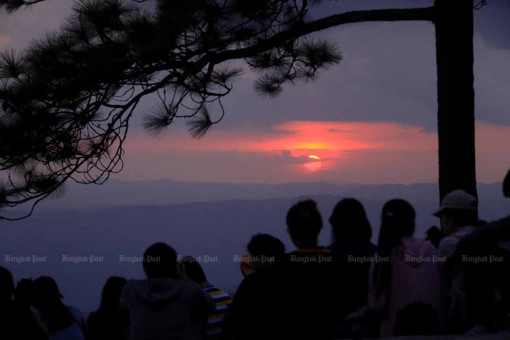Ministry unsure if construction should proceed amid ecological concerns

A long-proposed project stringing a cable car to the top of a mountain in Phu Kradueng National Park in Loei province is unlikely to come to fruition any time soon.
The Ministry of Natural Resources and Environment says any decision should be based on a study that will wrap up in 2025.
The idea of building a 4.4-kilometre cable car system was initiated in 1982 with the hope of increasing income from tourists.
The first and second environmental impact studies by Kasetsart University were conducted in 1984 and 1998, but were left on the shelf.
In 2012, the former Yingluck Shinawatra government dusted off the project.
The cabinet assigned the Ministry of Natural Resources and Environment, and Designated Areas for Sustainable Tourism Administration (Dasta) to conduct an Environmental Impact Assessment (EIA) on a budget of 23 million baht.
In 2016, the then-government of Prayut Chan-o-cha acknowledged the study and approved a budget of 633.89 million baht.
The Tourism and Sports Ministry supported the move, saying the cable car would provide an opportunity for the elderly to visit the park.
Normally, a visit to Phu Kradueng mountaintop requires a gruelling mountain climb of about 3-5 hours.
However, the project was put on hold again due to it being opposed by environmental activists, who argue that more tourists would lead to more garbage in the park and ruin the natural landscape and spoil its beauty.
Last year, Dasta and the Loei provincial administration held a meeting, which concluded that a study of the project was needed. They reviewed the engineering system, and environmental and economic impacts.
During a mobile cabinet meeting led by Prime Minister Srettha Thavisin in Nong Bua Lamphu province on Dec 4, the government acknowledged the project and approved 28 million baht for the study, according to Puangpet Chunlaiad, Minister of the Prime Minister’s Office.
Jatuporn Buruspat, permanent secretary of the Ministry of Natural Resources and Environment, said the ministry has not decided whether the project should proceed as many details have to be addressed, especially measures to limit the forest’s ecological loss from tourism activities.
He said the Department of National Parks, Wildlife and Plant Conservation (DNP) has approved a request by the study team from Dasta to explore the areas that would serve as the site of the cable car from this Nov 30 to Sept 30, 2025.
“We need to wait for the outcome of the study. Any decision about the project must be made by all stakeholders, not only one agency,” he said.
Based on the EIA report in 2012, the project would not damage the forest ecosystem due to the limited space required to build a cable car.
It said about 3 rai of land would be required for the cable car stations on the foothill and the mountaintop plus 1 rai for building the seven pillars needed to support the line.
The report said no big trees would be cut down but about 1,800 trees would be cleared out. It also said the project would have positive impacts, including increasing incomes for locals.
The study suggested measures to control the number of tourists based on the national park’s carrying capacity.
Dasta director Athikun Kongmee previously said this was one of many projects aimed at developing the northeastern region.
However, Assist Prof Sangsan Phumsathan, a lecturer at the Forestry Faculty of Kasetsart University, said the DNP should set a clear position on whether they want to preserve Phu Kradueng National Park as a pristine nature destination or use it as a tourism site.
“Many people believe Phu Kradueng is for adventure trekking, so the cable car would destroy its value. However, others believe a cable car would provide equal access for visitors with physical limitations,” she said.
“It is difficult to go ahead with this project due to these strong arguments. And it is harder to have a project in an area listed as an Asean heritage park. It’s also unclear if the measures to control tourists would really be effective.”
Environmentalist Sasin Chalearmlarp said he has not seen any plan by the DNP to curb tourist numbers, which could triple with a cable car service.

